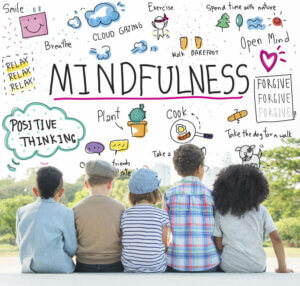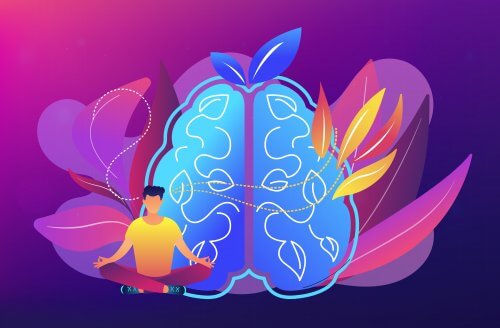5 Tips for Practicing Mindfulness in the Classroom

The term mindfulness has become very popular in recent times. We’ve almost all heard of mindfulness or have read something about the concept. Today, we want to focus specifically on how to begin applying mindfulness in the classroom.
We can define mindfulness as a psychological concept that involves full attention. It’s based on Buddhist meditation and total awareness of the here and now. And while it’s rooted in Buddhism, it’s a concept that people teach and practice today all around the world.
Learning to live mindfully means being aware of life. If you place your full attention on everything around you, your perception of life changes completely. In other words, mindfulness transforms your day-to-day life.
Children can start to apply mindfulness in the classroom by learning to concentrate by developing attention and relaxing their bodies. Empathy towards others is another capacity that develops through full attention.
5 tips for applying mindfulness in the classroom
Create an environment of stillness
To begin practicing mindfulness in the classroom, you must first find the right moment. This means establishing a time or place where teachers and students can pause for a few minutes and develop a sense of familiarity with silence.

Mindfulness is about how to gain awareness of the things in our environment and within ourselves in a new and different way.
If you can’t find a place for students to work on mindfulness, then you can use some white noise. It’s easy to download a white noise app to your phone, and this can help to calm even the most active students.
Full attention in the classroom environment
Every day, you should encourage your children to be more aware of the classroom environment. We’re talking about paying attention to the noises they hear, the textures they find, the colors and shapes they see…
If possible, you’ll perform attention and awareness exercises. For example, encouraging them to concentrate on some food before they eat it during lunchtime… focusing on its aroma, color, texture, etc.
If you pay attention, you’ll find it easier to be present in the moment. So, in the context of school, we’ll focus on the here and now that’s about to arrive in the morning or afternoon.
Daily guided meditations to practice mindfulness in the classroom
To apply mindfulness in the classroom, you should set aside a moment each day (or several times a week) for guided meditation with your students. Have them close their eyes, concentrate on their breathing, and guide them through meditation with your voice. You can also find many guided meditations online.
Mindfulness is simply being aware of what is happening right now without wishing it were different. Enjoying the present without holding on when it changes (which it will). Being with the unpleasant without fearing it will always be this way (which it won’t).
– James Baraz –
Compassion
It’s important to practice self-compassion and compassion for others. So, in this sense, you’ll concentrate on desires like the need to be happy, to feel safe, to be full of love.
Perhaps the first few times you do this with your class, your students will end up laughing. But, if you’re persistent, they’ll come to understand its value and enjoy the experience.

It’s possible to turn to compassion in times of tension, such as before an exam or as a group.
The importance of practicing gratitude
To begin practicing mindfulness in the classroom, you must cultivate gratitude in a natural and simple way. For example, you can set aside a few minutes in the classroom to reflect on and discuss the good things that have happened throughout the day.
Students can also do this in writing by creating a gratitude journal. Here, students and teachers can write about the persons, things, and events they’re thankful for. Or they can even express their gratitude through art
It’s important to remember the importance of patience when it comes to developing these ideas. You’ll need to deal with the challenges as they come. And this will help students to contextualize what they’re doing and why they’re doing it during every moment.
The term mindfulness has become very popular in recent times. We’ve almost all heard of mindfulness or have read something about the concept. Today, we want to focus specifically on how to begin applying mindfulness in the classroom.
We can define mindfulness as a psychological concept that involves full attention. It’s based on Buddhist meditation and total awareness of the here and now. And while it’s rooted in Buddhism, it’s a concept that people teach and practice today all around the world.
Learning to live mindfully means being aware of life. If you place your full attention on everything around you, your perception of life changes completely. In other words, mindfulness transforms your day-to-day life.
Children can start to apply mindfulness in the classroom by learning to concentrate by developing attention and relaxing their bodies. Empathy towards others is another capacity that develops through full attention.
5 tips for applying mindfulness in the classroom
Create an environment of stillness
To begin practicing mindfulness in the classroom, you must first find the right moment. This means establishing a time or place where teachers and students can pause for a few minutes and develop a sense of familiarity with silence.

Mindfulness is about how to gain awareness of the things in our environment and within ourselves in a new and different way.
If you can’t find a place for students to work on mindfulness, then you can use some white noise. It’s easy to download a white noise app to your phone, and this can help to calm even the most active students.
Full attention in the classroom environment
Every day, you should encourage your children to be more aware of the classroom environment. We’re talking about paying attention to the noises they hear, the textures they find, the colors and shapes they see…
If possible, you’ll perform attention and awareness exercises. For example, encouraging them to concentrate on some food before they eat it during lunchtime… focusing on its aroma, color, texture, etc.
If you pay attention, you’ll find it easier to be present in the moment. So, in the context of school, we’ll focus on the here and now that’s about to arrive in the morning or afternoon.
Daily guided meditations to practice mindfulness in the classroom
To apply mindfulness in the classroom, you should set aside a moment each day (or several times a week) for guided meditation with your students. Have them close their eyes, concentrate on their breathing, and guide them through meditation with your voice. You can also find many guided meditations online.
Mindfulness is simply being aware of what is happening right now without wishing it were different. Enjoying the present without holding on when it changes (which it will). Being with the unpleasant without fearing it will always be this way (which it won’t).
– James Baraz –
Compassion
It’s important to practice self-compassion and compassion for others. So, in this sense, you’ll concentrate on desires like the need to be happy, to feel safe, to be full of love.
Perhaps the first few times you do this with your class, your students will end up laughing. But, if you’re persistent, they’ll come to understand its value and enjoy the experience.

It’s possible to turn to compassion in times of tension, such as before an exam or as a group.
The importance of practicing gratitude
To begin practicing mindfulness in the classroom, you must cultivate gratitude in a natural and simple way. For example, you can set aside a few minutes in the classroom to reflect on and discuss the good things that have happened throughout the day.
Students can also do this in writing by creating a gratitude journal. Here, students and teachers can write about the persons, things, and events they’re thankful for. Or they can even express their gratitude through art
It’s important to remember the importance of patience when it comes to developing these ideas. You’ll need to deal with the challenges as they come. And this will help students to contextualize what they’re doing and why they’re doing it during every moment.
All cited sources were thoroughly reviewed by our team to ensure their quality, reliability, currency, and validity. The bibliography of this article was considered reliable and of academic or scientific accuracy.
- Kuyken, Willem. Effectiveness of the Mindfulness in Schools Programme: non-randomised controlled feasibility study. The British Journal of Psychiatry. (2013).
- Hoy, Wayne K., Charles Quincy Gage III, y C. John Tarter. School mindfulness and faculty trust: necessary conditions for each other?. Educational administration quarterly. (2006).
- Justo, C. F., Mañas, I. M., & Martínez, E. J. Reducción de los niveles de estrés, ansiedad y depresión en docentes de educación especial a través de un programa de mindfulness. Revista de Educación Inclusiva, 2(3). (2016). https://revistaeducacioninclusiva.es/index.php/REI/article/view/40
- Romera Marín, C. Mindfulness en el aula: un proyecto para educar niños conscientes . Universitat Jaume I. (2017).
- Simón Vicente. Meditación de la respiración. Youtube. (2011). https://www.youtube.com/watch?v=rOa0EYX0pgE
- Vive. (2020). ¿Cómo aplicar el mindfulness en el aula? UNIR. https://www.unir.net/educacion/revista/mindfulness-en-el-aula/
This text is provided for informational purposes only and does not replace consultation with a professional. If in doubt, consult your specialist.








